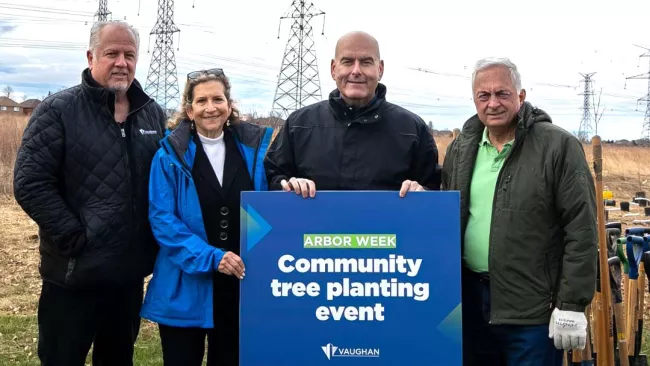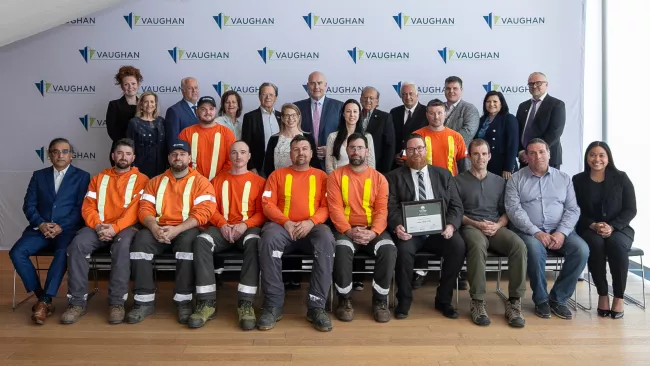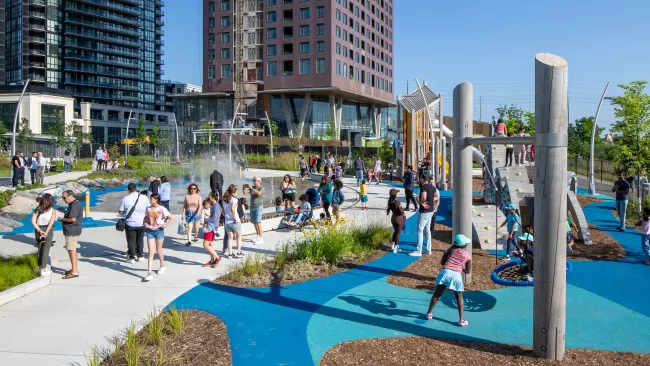Answering your tree maintenance questions
Vaughan is home to more than 135,000 trees that enhance the quality of life in our community – and maintaining them is important to our ecosystem's health and prosperity. While it’s our job to prune and protect them, sometimes, it’s necessary for City of Vaughan crews to remove an unhealthy or dangerous tree.
You may be wondering when or why? We’re answering your top questions about the City of Vaughan’s tree maintenance program.
Why does the City remove trees?
We remove trees that pose a risk to our community. They may have a terminal disease, safety hazards, or obstruct vehicle and pedestrian clearances, streetlights, buildings and utilities.
How does the City remove trees?
Our Forestry team removes trees in a justified and safe way, with minimal environmental impact, following this procedure:
- Assess and evaluate: We identify trees through routine tree inspections or when a resident submits a service request to Service Vaughan. A City forestry inspector will inspect the tree within 30 business days to assess its health and determine next steps.
- Schedule the work: Once an inspector has confirmed the need for a tree’s removal, a work order is created and addressed in priority sequence. If a tree on City property is being removed close to a residential property, City staff will notify the nearby homeowner with a door hanger, phone call, email or knock on the door to inform them of the reason, next steps and timing.
- Remove the tree: When it's time to remove the tree, staff set up a boundary to safely complete the work. Crews make every effort to keep the work area secure so pedestrians and nearby landscaping are safe. Larger trees can take several days to remove. This step can take up to eight months to begin after creating a work order.
- Remove the stump: Stump removal is scheduled systematically, happening at a separate time from tree removal as it requires different machinery. In some cases, if the stump is small enough and a tree is slated for replacement in the same location, the stump will be removed when the new tree is planted. Timing depends on the season as stump removal is typically paused from Dec. 30 to the end of April due to cold temperatures, frozen ground and/or snow.
- Soil and seed: After removing the stump, crews will use soil to fill the hole and apply grass seed.
How long after I submit a service request does it take for City staff to visit the tree site?
Requests to address tree conditions that pose a danger to the public are dealt with as soon as possible. Non-emergency requests that follow our pruning schedule will be addressed accordingly, while all other requests will be managed in priority sequence, following an inspection. The forestry inspector will contact you (by phone or leave a notice on your door) with the status of your request. Please note: it can take up to eight months for a tree to be pruned or removed due to a high volume of service requests.
The City completes stump removal and tree planting using separate large-scale contracts to leverage the best possible pricing and deliver best value to Vaughan taxpayers. It can take up to 12 months for a stump to be removed and an additional 12 months for a replacement tree to be planted because these services are completed in large groupings.
How often does the City prune trees?
Through a Council-endorsed Tree Maintenance Strategy (PDF), we are transitioning to a cycle in which trees are pruned every seven years. This strategy includes increased tree inspections and allows us to adopt a more cost-effective approach to tree maintenance, reflecting our ongoing commitment to Environmental Sustainability, Service Excellence and Accountability, as outlined in the 2022 to 2026 Term of Council Strategic Priorities. The Tree Maintenance Strategy also prioritizes quality services by managing and improving the urban forest, as designated by our Urban Forest Management Plan, and increasing canopy cover, which is essential to the overall health of the Vaughan community and ecosystem.
How are trees pruned?
Our team prunes trees according to species, age, and, in some cases, location. Together, these factors determine the type of pruning method to use, which include the following:
- Crown cleaning removes dead, dying, diseased, crowded, weakly attached or unhealthy branches from the crown (or top) of a tree.
- Crown clearance is the selective removal of tree branches to provide clearance for buildings, cars, people, streetlights, traffic signals, roads, regulatory signage and sight lines.
- Crown complete is the holistic pruning of a tree that includes cleaning and clearance.
- Crown establishment is the selective pruning of the crown of newly planted trees to promote an esthetically and structurally sound branch system.
- Crown reduction lessens the size of a tree to make room for utility lines.
- Crown restoration removes damaged branches to restore a stable form to the tree. This method is often necessary following storm damage.
- Crown thinning is the selective removal of branches to increase light and air movement through the crown. Thinning opens the leaves of a tree, reduces weight on heavy branches, reduces water intake and helps retain the tree's natural shape.
After pruning, a tree might look bare, but don’t worry! It will start to look normal during the next growing season, with a healthier and more attractive form.
How do I report a fallen branch or tree that poses a risk to the public?
To report a municipal emergency or problem that requires immediate attention, call Service Vaughan at 905-832-2281 or email at service@vaughan.ca. The following are considered municipal emergency tree maintenance requests:
- fallen limb
- fallen tree
- hanging broken branch
- leaning/uprooted tree
- split/cracked tree
Learn more about our Forestry operations at vaughan.ca/trees and vaughan.ca/UrbanForest.
For updates and news as they happen, subscribe to Vaughan News and follow the official corporate channels on X, Facebook, Instagram and LinkedIn.





